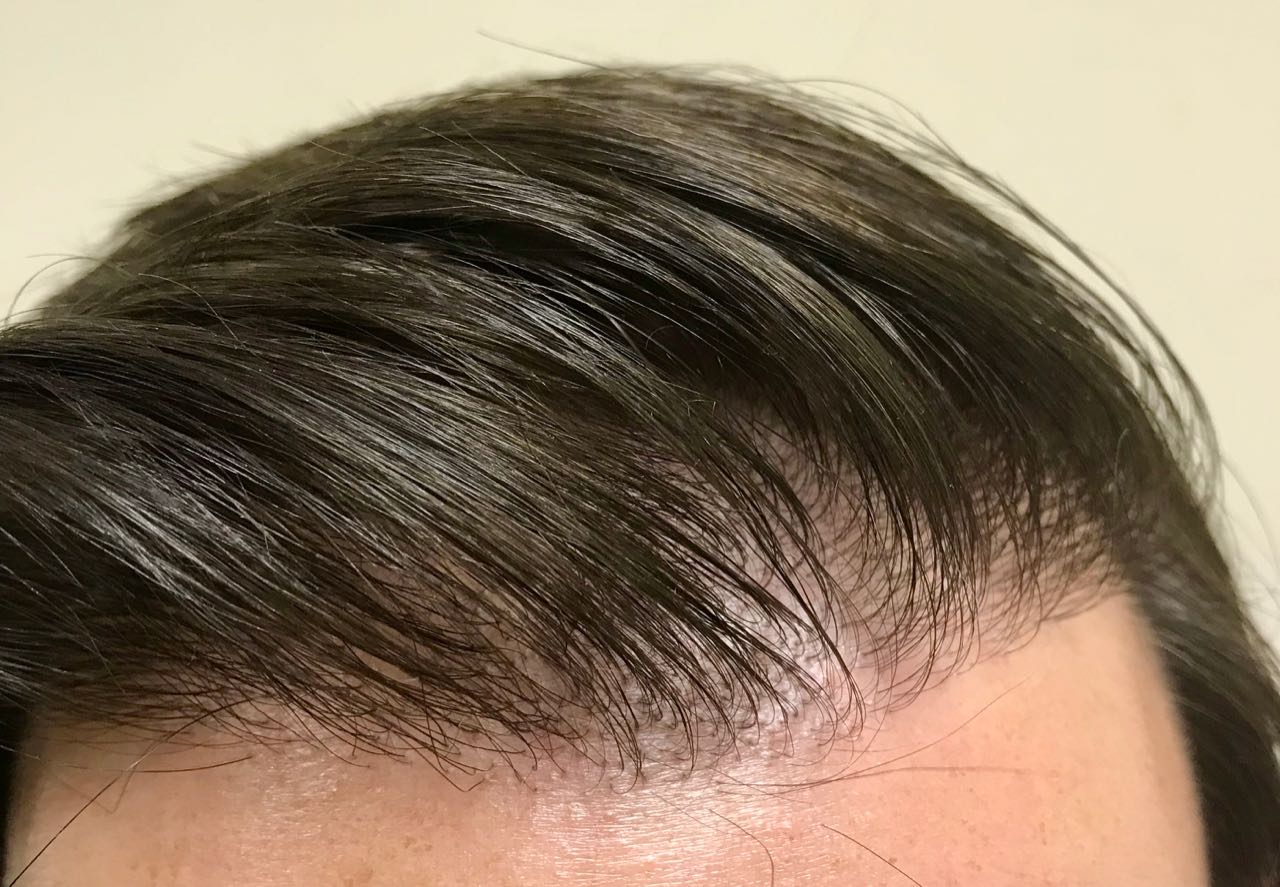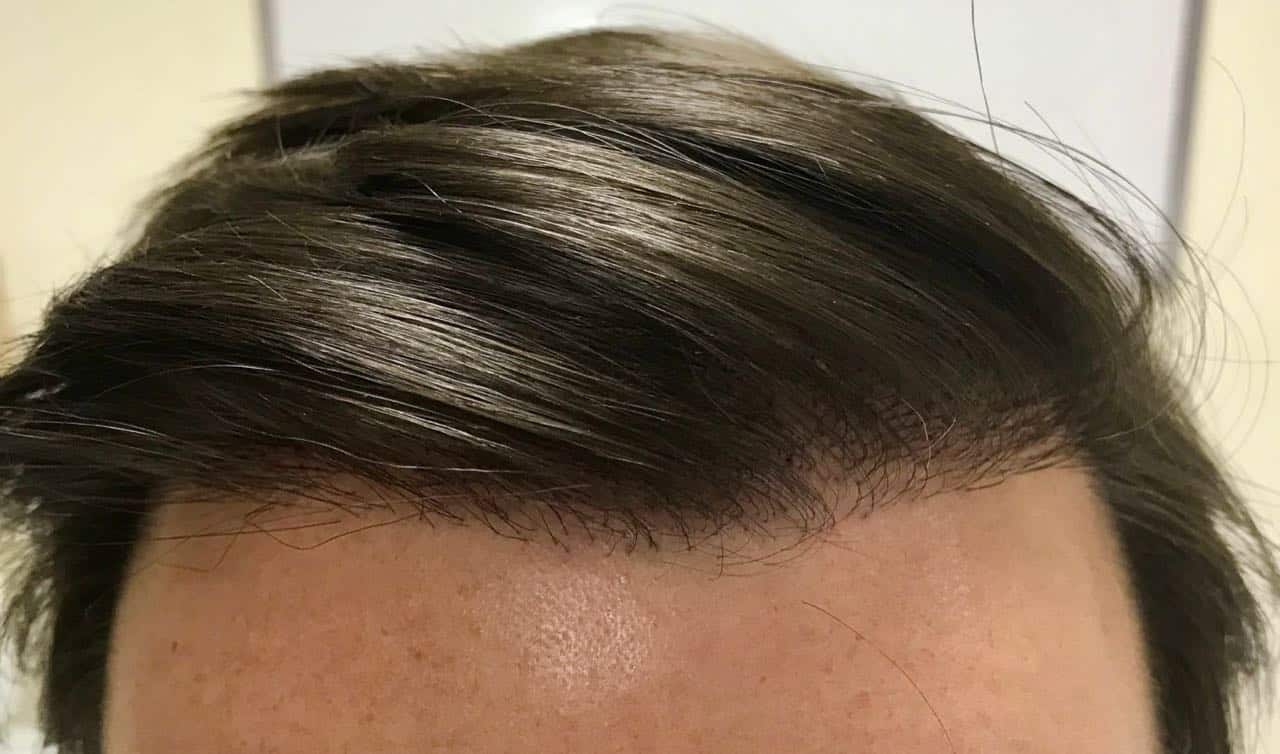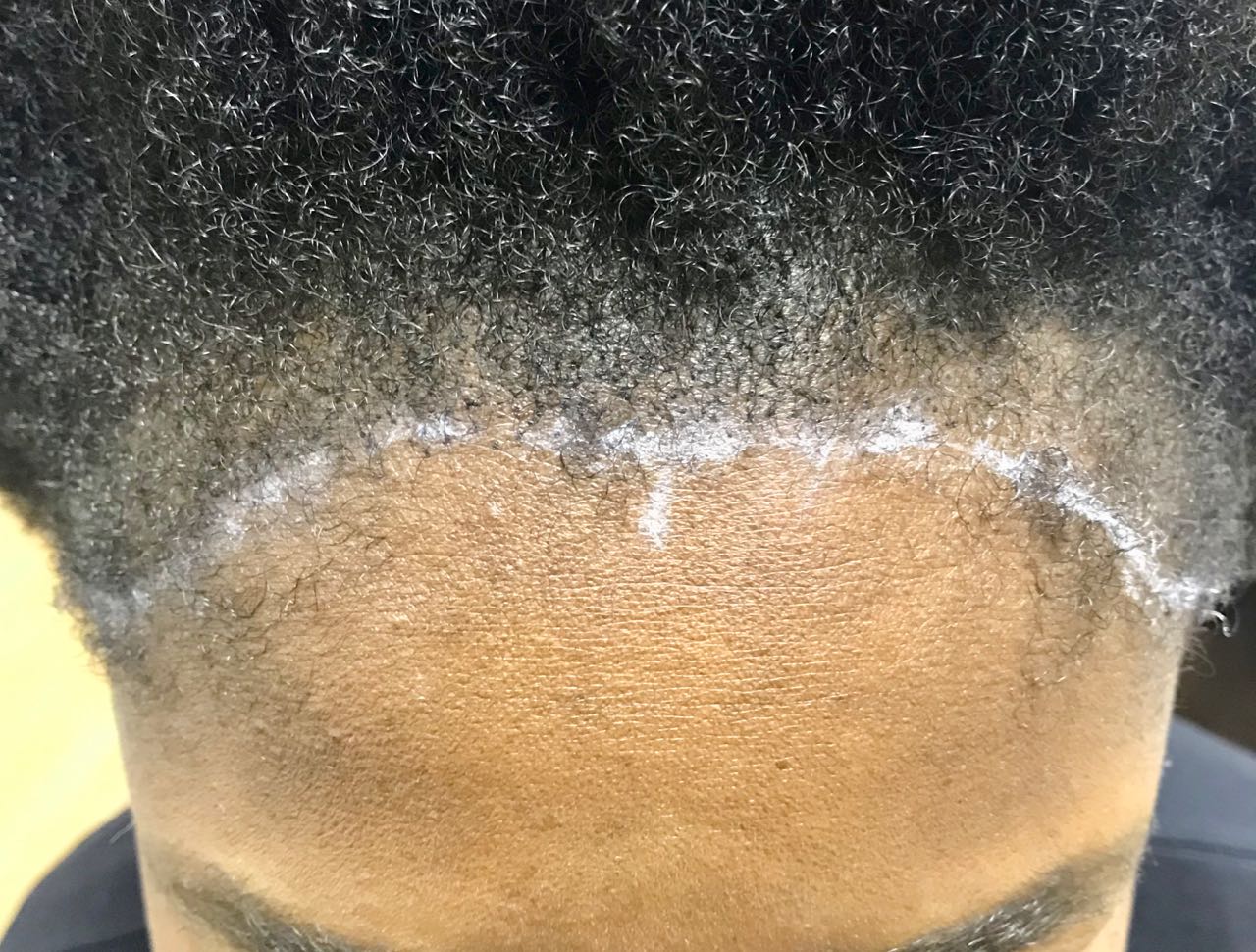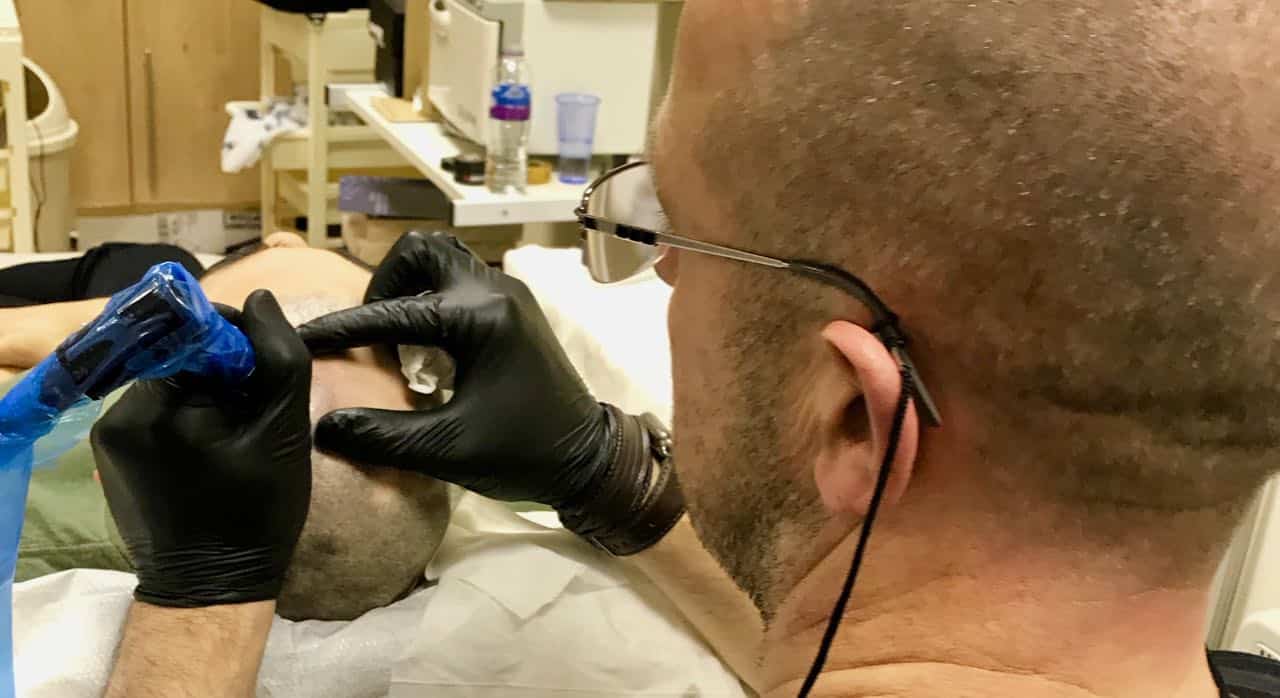So, what is Micropigmentation?
Firstly, micro pigmentation or a scalp tattoo is not a hair growth treatment. Furthermore it is not creating hair, or artificial hair. Its not a type of hair surgery either. Micropigmentation is the creating of hair follicle like marks on the scalp. The marks are created by a scalp tattoo ink pen with a fine needle. The tattoo ink pen penetrates the Epidermis leaving a mark on the top layer of the Dermis. Maybe you have heard of this before? A small wound in created that causes a scab that will fall within a short time. The immune response will cause the pigment to shrink in most cases and fade over time (years). Different shades of pigment are administered over a series of 3 sessions. Session times can range from 1-4 hours.
Our Practice
Our clinic has been in the hair treatment industry since 1964. This type of scalp tattoo was first thought of in the 80’s but never really took off. I would say this was due to the lack of appropriate equipment and the non permanent inks available. Nowadays, the ink lasts for Years with perhaps a top up required after 3-5 years. Technology has come a long way allowing us now to create a hair look that is visually undetectable.
When is Micropigmentation used?
First of all there are numerous times when micropigmentation or scalp tattoo can be used. As a rule any type of hair loss with permanents. Also skin conditions resulting in scarring. Maybe you have heard of some of the following?:
- Male Pattern Baldness
- Female Patterm Baldness
- Scarring Alopecias (Lupus, Lichen Planus, Frontal Fibrosing
- CCCA
- Alopecia Areata
- Alopecia Totalis
- Alopecia Universalis
- Traction Alopecia
- Scar Tissue
- Keliods
- Shaving bumps
- Burn Covering
This list goes on and on.
%
Of men under 50 years will show significant levels of hair loss
%
Of Women will show Permanent thinning before they are 50 years.

Subtle difference in the thickness as you can see. It has to look Natural. In this case the patient has had the frontal hair line thicker up with micro pigmentation after an FUE Hair Transplant Procedure.

What other Options are there?
Hair Transplant FUE or FUT – Maybe this is an option for you? Both FUE and FUT procedures involved taking donor hair from the back of the head and transplanting it to the recipient region. In both FUE and FUT you are left with scars albeit generally undetected. Most noteworthy, when hair is transplanted the thickness can not be completely replicated. Therefore Micropigmentation is often used to thicken up between the grafts which like the image about shows is highly effective. Also the hair looks as natural as the implants themselves.
A Closer look at Micropigmentation
So you know now that we use scalp tattoo ink to create small follicular unit marks on the skin. This creating the illusion of thickness and of course having more hair. The needles themselves are extremely small (0.2mm approx).
How Long does it take?
This is dependent on the size of the job. Also the type of skin and length and amount of hair present. We could be applying 30,000 – 40,000 micro dots on the scalp tattoo when we use micro pigmentation. These are individually implanted by hand. Furthermore, each individual implant required a unique pressure and angle to ensure the correct amount of ink is applied.
Therefore to accurately give you a time frame is difficult. As a rule we divide each Micropigmentation patient into three sessions. The first to establish the first layer. The second to fill in the gaps and add shading to add the authentic look. Finally the third session to complete the process and touch up any loose pigment.

Drawing a hair line to blend in to the existing follicular units. Each session building up the layers to ensure that natural look.
Free Consultation
Firstly, the best advice is to arrange a consultation. I will run through the process in detail and answer any questions you have. Furthermore its a free service and you get to see that we are a medical establishment which take cleanliness and professionalism as a priority. You will find many clinics set up in beauticians, hairdressers and perhaps tattoo stations. In most cases none of which are hair or skin specialists. Therefore you have no idea if it’s safe to conduct this procedure on your scalp. Remember, event though this is a simple but lengthy process, we are injuring your skin. In fact we are creating potentially thousands of wounds that could have complications. We are a TTS registered hair clinic that specialist in skin disease, hair loss, hair transplants and of course the scalp tattoo micropigmentation. So you know that its safe to conduct the procedure and you know it is being administered by a skin specialist.
To arrange a free consultation please drop us a line or give us a call an we will invite you in at an appropriate time. Thanks and look forward to seeing you soon.

This Patient fell asleep
Is it Painful?
So does it hurt? A question I get asked all the time. Tattooing is inherently painful for some. Furthermore, everyone has a different pain threshold. So let me tell you, A scalp tattoo doesn’t penetrate as far as a tattoo. The instances of discomfort are momentary. Also I find that most patients find this process therapeutic and not painful. Furthermore, different spots on the head maybe more sensitive. So the answer is yes if might give you some discomfort but most have no issue with this procedure. In fact I’ve had several patients fall asleep.
Price Range – from £350.00-£1900.00
Firstly, every patient is different and vary in the time it takes. The following factors are taken into consideration: size or area, length of hair, pain tolerance, patient availability, type and area of scar and type of skin. The overall factor is how long will it take for us to conduct the procedure. Micropigmentation can take up to 10 hours to perform. This is not all in one go of course. We never rush a job. But you will soon see that once we start we don’t mess around.
Recovery Time
Firstly, micropigmentation is less invasive that that of a tattoo hence the feeling of pain is minimal. Furthermore, most patients find it comfortable and in some cases therapeutic. Recovering from this will take a matter of a few days. There is likely to be some minor inflammation and redness. This tends to last for 24-48 hours. Remember the ink is positioned at the top of the dermal layer therefore skin injury is small and skin recovery in most cases is quick. The equipment used today also reduces recovery.
Therefore, don’t worry as recovery is quick. Follow up treatments may be administered after 7 days. Albeit I tend to leave it a few more days to be sure the skin has healed.
Shaving
Men who have a scalp tattoo often ask how quickly can they shave the head? typically, around 10 days is in most cases deemed the right time. However, as long as the scabs have fallen then shaving with a foil razor is deem appropriate.
Micropigmentation Side Effects
There are virtually no side effects. There will be some redness as mentioned above. The dots themselves will be darker to start with. As the skin heals they will reduce in size and colour. Any scabs that form on top of the skin will fall off within a few days. Most importantly, the one major side effect can be that of a reaction to the skin. Even though the ink is considered safe, some skin may react hence a patch test should be conducted.
Men or Women?
Micropigmention may be use on both men and women. Men and women suffer hair loss in similar and different ways. Remember, this procedure is not designed to make hair grow. Albeit in some cases like Alopecia Areata it may actually help. The main reason why patients go for this option is to increase the skin follicular density therefore thickening up the appearance of hair. So, men and women can use this as an extremely effective way of making the hair look much thicker.
Androgenic Alopecia
Men, when suffering from Male Pattern Baldness will loose the hair on top of the head only. The sides are not affected. Women, when suffering from female pattern baldness may well loose hair on a permanent basis throughout the scalp. So men have a choice of adding to the thickness of longer hair or as in most cases create a full head of hair by adding the dot system to the areas of loss. The head will be completely shaved to make the micropigmentation blend into the natural hair without trace. Thickening up the hair is the method most women use. This darkens up the skin reducing the colour between the skin and hair, so the hair looks thicker.

So here is an example of when a micropigmentation might me used? Male Pattern Baldness covering the crown. Alternatively, FUT or FUE is an option.
- SMP is a permanent procedure which some men may view as a disadvantage. Because the hair pattern stays the same – much like a tattoo on your skin – changing it requires the laser removal process.
- Prolonged exposure to the sun’s ultraviolet rays can increase the rate of fading. This would require the patient to visit an SMP clinic more often for touch-ups.
- Men need to keep their hair very short to fully take advantage of the SMP’s look.
SCALP MICROPIGMENTATION VS. OTHER HAIR LOSS TREATMENTS
Scalp micropigmentation is among the newest treatments for hair loss available today and, as mentioned, has grown steadily ever since being introduced to the general public. SMP’s “hair tattoo” approach is unique when compared to other types of hair loss treatments.
Here’s a closer look at other treatments available today. Treatments include medications, hair loss shampoos, surgery, and even wigs and hair pieces, among other hair growth products.
1. MEDICATIONS
Men have used drugs to treat hair loss for many years. The most popular types of medication are Minoxidil and Finasteride; both have Food and Drug Administration (FDA) approval.
MINOXIDIL
Also known as Rogaine, minoxidil is an over-the-counter product that comes in either liquid or foam that you apply to your scalp twice a day.
Minoxidil first was introduced as an oral medication to treat high blood pressure. One of its side effects, however, was that it caused hair growth – and from there the topical Minoxidil solution to treat hair loss was born.
Minoxidil works by stimulating hair follicles to grow hair on your scalp, but also anywhere on your body. It widens blood vessels, which allows additional oxygen, blood, and nutrient to flow to your hair follicles
It takes very little time to apply Minoxidil to your head. Users should wait at least eight hours between applications and apply the foam or liquid evenly throughout the scalp. Results vary for different individuals, but most users report seeing results within two to six months.
There are pros and cons to using Minoxidil:
PROS
- Perhaps the biggest advantages to using Minoxidil are that it’s easy to purchase (you don’t need a prescription) and its relative ease of use. Others have found it useful to use after a hair transplant because it boosts the results of hair restoration.
CONS
- One of Minoxidil’s cons is that it’s not as effective for advanced hair loss. That said, men over 30 may not experience the same results as younger men who have experienced minimal hair loss. As mentioned, Minoxidil patients don’t experience results immediately and may experience “shedding” early in the process as new-growth hair follicles push out old hairs.
- Only the 2 percent solution of Minoxidil is approved for women. The stronger 5 percent solution puts women at an increased risk for low blood pressure and hypertension. It may also cause unwanted hair growth for women.
FINASTERIDE
Most commonly known as Propecia, Finasteride is available to men only, and only by a prescription from a doctor. It comes in pill form and taken once daily.
Finasteride works to restore hair by converting testosterone to dihydrotestosterone, a hormone that shrinks hair follicles. One (1 milligram) dose of Propecia may lower DHT levels in the scalp by as much as 60% when used daily. Many users have reported significant hair growth while using Finasteride.
PROS
- Finasteride lowers DHT levels, which many consider the only effective way to slow and stop the hair loss process. It’s also easy to use because it comes in pill form.
CONS
- You need to keep taking Finasteride to retain its benefits. More serious side effects include an increased risk of prostate cancer, as well as a diminished sex drive and sexual function.
- Also, women who are pregnant or may become pregnant should never handle Propecia tablets because they may cause birth defects.
2. HAIR TRANSPLANT SURGERY
Hair transplant surgery involves moving hair you already have and transplanting it to an area of your scalp where there’s no hair or thinning hair. There are two methods of hair transplant: follicular unit strip surgery (FUSS) or follicular unit extraction (FUE).
During FUSS surgery, your doctor will remove a strip of skin from the back of your head (the area remains hidden by the hair around it). The strip of removed skin is divided into tiny grafts, which each graft consisting of an individual hair or a few hairs.
FUE surgery involves shaving the back of your scalp and the surgeon extracting individual hairs one by one.
The procedure for transplanting hairs is the same for both procedures. Grafts are inserted into individual holes or slits created in your scalp by a scalpel or needle. The typical hair transplant treatment last four to eight hours.
Other types of hair transplant procedures include flap surgery, tissue expansion, and scalp reduction. These types of surgeries can are used alone or in combination to provide the best results for each patient.
PROS
- Hair transplant patients typically see long-term results that don’t need follow-up treatments. Transplants also involve the re-growth of natural hair.
CONS
- There are disadvantages to hair transplant surgery, including the cost – which can range anywhere from $4,000 to $15,000. Most insurance plans don’t cover the cost of surgery. Also, hair transplant treatment only works if you have (transplantable) hair on other parts of your scalp.
- Some patients also report irritation after their hair transplant procedure, including itching and bumps, while in some cases the transplanted hair had fallen off before it had a chance to grow.
3. OTHER METHODS
There are some other methods for managing hair loss, including diet and supplements. Nutritionists recommend a diet that includes sufficient amounts of protein – which strengthens hair and is said to promote hair growth – while others claim that supplements such as iron, biotin, zinc help slow hair loss. You shouldn’t take iron supplements unless you have anemia. For the most part, however, there’s not enough evidence to show that supplements promote hair growth.
Wigs and hairpieces are sometimes used by people who don’t respond to other types of treatments. Insurance may cover the cost of a wig or hairpiece if your hair loss is due to a medical condition.
CONCLUSION
While there is a variety of methods used to treat hair loss and baldness, scalp micropigmentation is very effective to treat several conditions, including thinning hair and hair recession. It’s the fastest-growing hair loss treatment available and its results are evident in countless patients.
YOU MIGHT ALSO LIKE:
How to Stop Hair Loss in Men & Women Using These 15 Methods
Why You Seriously Need a Beard with a Bald Head
7 Things About Shaving Your Head (And When It’s Time)
How Long Does it Take to Go Bald? The Answer May Surprise You
Why Am I Going Bald? Here’s A Closer Look…
Best Men’s Hair Products for Thin Hair That Work Great

